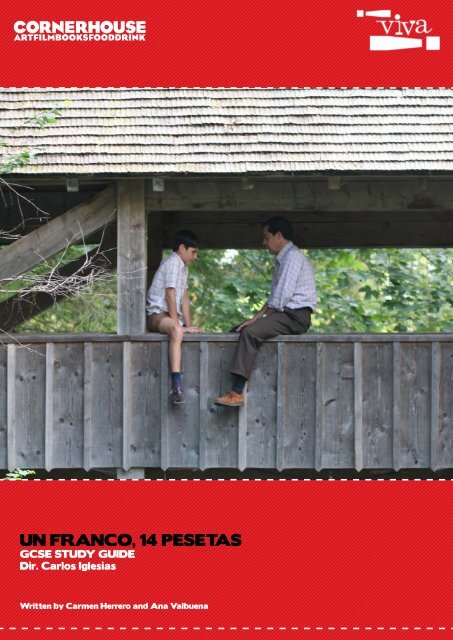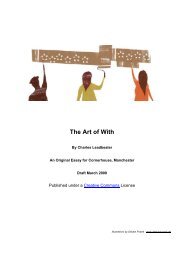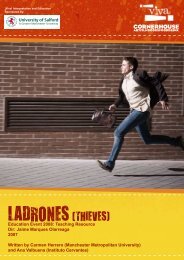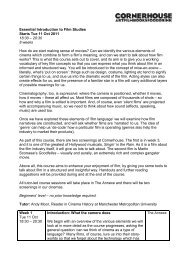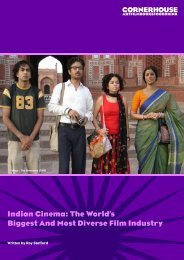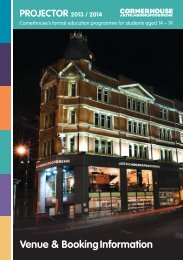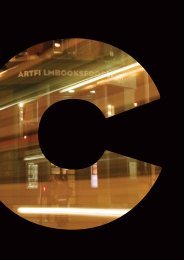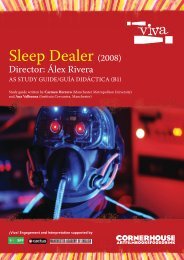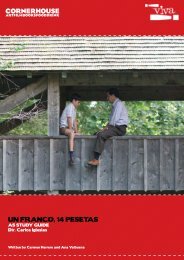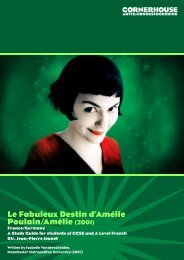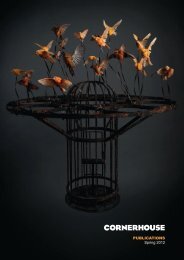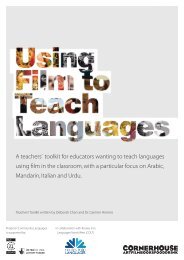UN FRANCO, 14 PESETAS - Cornerhouse
UN FRANCO, 14 PESETAS - Cornerhouse
UN FRANCO, 14 PESETAS - Cornerhouse
You also want an ePaper? Increase the reach of your titles
YUMPU automatically turns print PDFs into web optimized ePapers that Google loves.
<strong>UN</strong> <strong>FRANCO</strong>, <strong>14</strong> <strong>PESETAS</strong>GCSE STUDY GUIDEDir. Carlos IglesiasWritten by Carmen Herrero and Ana Valbuena
<strong>UN</strong> <strong>FRANCO</strong>, <strong>14</strong> <strong>PESETAS</strong>GCSE STUDY GUIDECURRICULUM LINKSGSCE LEVEL TOPICS: Work and lifestyle, social and historicalissues.Themes include work, immigration, friendship, family and historicalevents.SINOPSISEspaña, 1960. Dos amigos, Martín y Marcos, deciden marcharsea Suiza en busca de trabajo. Dejan a sus familias en Españay emprenden un viaje hacia una nueva vida en la Europa delprogreso y las libertades. Allí descubrirán una mentalidad muydiferente a la que deberán adaptarse, trabajando como mecánicosen una fábrica y viviendo en un pequeño pueblo industrial. Conla llegada de Pilar, la mujer de Martín, con su hijo Pablo, y de MªCarmen, la novia de Marcos, se les termina la vida de hombressolteros que llevaban en un país con tanta libertad. El trabajo siguesiendo el día a día de Martín y Pilar, mientras el pequeño Pablocomienza a ir al colegio y a integrarse. Con la muerte del padrede Martín, se plantean que lo que habían ido a buscar ya lo hanconseguido y es hora de regresar. Para su sorpresa, será másdifícil la vuelta que la ida.SYNOPSISSpain, 1960. Two friends named Martín and Marcos decide to lookfor jobs in Switzerland. They leave their families behind in Spainand head off on their journey to the free, progressive part of Europe.They will have to adapt to a very different way of life there, workingas mechanics at a factory and living in a small industrial town. Thearrival of Martín´s wife Pilar and son Pablo, and Marcos´girlfriend,María del Carmen, marks the end of the bachelor life they wereliving in a country with lots of freedom. Martín and Pilar´s everydaylife is their work, while little Pablo starts going to school and makingthe new place his home. When Martin´s father dies, they realizethey’ve already got what they went there for and it is time to return.Much to their surprise, going home is much harder than leavingwas.(Fuente: Press Book de la película)
<strong>UN</strong> <strong>FRANCO</strong>, <strong>14</strong> <strong>PESETAS</strong>GCSE STUDY GUIDECREDITS/TÍTULOS DE CRÉDITODirector: Carlos Iglesias.Country/País: España.Year/Año: 2006.Length/Duración: 105 min.Genre/Género: Drama, comedia.Script/Guión: Carlos Iglesias; en colaboración con Central de Guiones.Production/Producción: José Manuel Lorenzo, Eduardo Campoy y Susana Maceiras.Music/Música: Mario de Benito.Photgraphy/Fotografía: Tote Trenas.Editing/Montaje: Luisma del Valle.Artistic director/Dirección artística: Enrique Fayanás.Cast/Ficha artística: Carlos Iglesias (Martín), Javier Gutiérrez (Marcos), Nieve de Medina (Pilar), IsabelBlanco (Hanna), Iván Martín (Pablito), Tim Frederik (Pablo), Eloísa Vargas (Luisa), Aldo Sebastianelli(Tonino), Ángela del Salto (Carmen).BEFORE THE SCREENING/ACTIVIDADES ANTES DE VER LA PELÍCULA• The director experienced a similar story to the one told in the film. In pairs or small groups read thefollowing sentences and try to find the same information in the text written by the director.El director de esta película vivió una historia parecida a la que relata en la película. En parejas opequeños grupos, intentad buscar la información de las frases en inglés en el texto escrito por eldirector.
<strong>UN</strong> <strong>FRANCO</strong>, <strong>14</strong> <strong>PESETAS</strong>GCSE STUDY GUIDE1. Those were tough years: my father and his friend were both highly skilled workers at Spain´s bestfactory at that time and they couldn’t afford to buy their own home.2. We lived with my grandparents in the basement apartment they had as the superintendents of anapartment building.3. I left the basement behind and was taken to a wonderful place with a river and woods where I couldride my bicycle in the summer or go sledding in the winter.4. From the start, we learned that “what belongs to everyone is more mine than what is mine”, and I’venever forgotten it.5. I filmed in the house I grew up as a child and even today when you open the windows you can see thesame scenery that could be viewed as a young boy.6. When I was told we were returning to Spain, it didn’t upset me because I expected it, but once I gotthere, it was traumatic.7. Switzerland has 7 million inhabitants now and 2 million immigrants. There are still 90,000 Spaniardsliving there.EL NIÑO DE LA PELÍCULA SOY YOMi padre dice que los mejores años de su vida fueron los que pasó en Suiza, de 1960 a 1966. Vivirallí nos abrió los ojos y fue muy difícil encajar la vuelta. Eran años difíciles: mi padre y su amigoeran dos oficiales de primera en la mejor fábrica del momento en España y no podían pagar supropio piso. Por eso vivíamos con mis abuelos en el sótano que les correspondía por ser porterosen una finca del barrio de Argüelles.Tiempo después de haberse marchado mi padre y su amigo a Suiza, un día mi madre me cogió,me llevó al tren, pasamos muchas horas de pie en el vagón, y… ¡llegamos a un jardín! Salí de unsótano y me llevaron a un lugar maravilloso con un río, bosques, donde podía ir con la bicicletaen verano o jugar con el trineo en invierno. He rodado en la casa donde me crié y a día de hoy, alabrir las ventanas, el paisaje sigue siendo el mismo que veía cuando era niño. Allí, desde el primermomento, aprendimos que “lo que es de todos es más mío que lo mío”, y no lo he olvidado nunca.Cuando volví a Madrid, ya con doce y trece años tenía discusiones con los otros chavales porquedecían que los niños nacían… ¡por el ombligo! Yo alucinaba porque a mí me habían dado educaciónsexual en el colegio. Aquello era un mundo impensable para los españoles, con lagos nudistas,bailes donde sacaban a bailar las chicas, quienes llevaban la iniciativa sexual, además. Las suizasse sentían muy halagadas con los piropos. Incluso vi debates en televisión sobre por qué lasmujeres suizas se casaban con italianos y españoles, que qué estaba pasando.Cuando me anunciaron que nos veníamos, para mí fue algo normal, no me impresionó. Teníala idea de que en España estaba mi familia, mis abuelos, mis tíos. Lo traumático fue cuando yaestaba aquí. Desde que tengo 18, he ido todos los años a Suiza. Y a mis mejores amigos siempreles he llevado a conocer donde viví. Suiza tiene ahora 7 millones de habitantes y 2 millones deinmigrantes. Allí siguen viviendo 90.000 españoles.Les reproché mucho a mis padres haber vuelto. Pero cuando escribí el guión de esta película, medecía que de haberme quedado en Suiza igual hubiese sido mecánico fresador en vez de actor. Encualquier caso ésta es una historia contada desde la perspectiva y la comprensión que da el tiempo,y desde la ternura y humanidad que da el haberla vivido.(Fuente: Press Book de la película)
<strong>UN</strong> <strong>FRANCO</strong>, <strong>14</strong> <strong>PESETAS</strong>GCSE STUDY GUIDE• Bearing in mind the information from the synopsis and the director’s notes, what topics do you thinkthe film is going to be dealing with?Teniendo en cuenta la información de la sinopsis y de las notas del director, ¿qué temas crees queva a tratar la película?• What do you think about the two characters in the film cover? What is their relationship? Where arethey? What do you think they are talking about? Share your thoughts with your classmates.¿Quiénes son los dos personajes que aparecen en la carátula de la película? ¿Qué relación hayentre ellos? ¿Dónde están? ¿De qué crees que están hablando? Comparte tus opiniones con tuscompañeros.• What sort of problem do you think an immigrant leaving his country in search of work has? In smallgroups talk and make a list with as many words as possible.¿Qué tipos de problemas crees que tiene un emigrante que abandona su país en busca de trabajo?Habla con tus compañeros e intentad hacer una lista con el mayor número de palabras posible.ACTIVITIES WHILE WATCHING THE FILM/ACTIVIDADES AL VER LA PELÍCULA• Characters and settings in this film are very important. How would you describe the main charactersin the film? Think about a few things to say about each of them. You can also choose among thelist of adjectives we give you. Ask your teacher the meaning of any new words.Los personajes y los lugares que se presentan en la película son muy importantes. ¿Cómodescribirías a los personajes principales? Piensa en algunas cosas para decir sobre cada uno deellos. Elige también entre la lista de adjetivos que te damos los más adecuados para cada uno deellos. Pregunta a tu profesor/a el significado de todas las palabras nuevas que encuentres en lalista.
<strong>UN</strong> <strong>FRANCO</strong>, <strong>14</strong> <strong>PESETAS</strong>GCSE STUDY GUIDEtrabajador/a inocente emprendedor/a acogedor/a valientedecidido/a amigo/a joven adaptable luchador/aCómo es(gustos, ideas, etc…)Relación con losdemás personajesMartín Pilar Marcos Hanna PablitoA qué se dedicaQué hace en un díanormalMás datosOtros datos• There is a drastic difference between Switzerland and Spain and how the two countries in the 60’sare depicted in the film. In small groups try to describe the main differences between them. Thinkabout: scenery, buildings, streets, the houses the people live in, their way of life, work opportunities,attitude to women, etc.Hay una gran diferencia entre España y Suiza, los dos países que se retratan en la película en losaños 60. En pequeños grupos, describid las diferencias que se pueden establecer. Pensad en:paisajes, edificios, calles, las casas en las que vive la gente, cómo viven, las oportunidades detrabajo, actitud hacia la mujer, etc.EspañaSuiza• Edificios• Paisajes• Forma de vida• Nivel de vida• Creencias• Otros datos
<strong>UN</strong> <strong>FRANCO</strong>, <strong>14</strong> <strong>PESETAS</strong>GCSE STUDY GUIDE• Think about how the camera helps to tell the story of the film. Why did the director choose differentshots at different times?Vamos a considerar cómo la cámara sirve para contar la historia de la película y de qué modo eldirector elige entre los diferentes planos para cada ocasión.-Long shot/Planos generalesWhere you can see things far away/in the distance as well as near to the camera.-Close up shot/Primer planoWhen you can see a small detail of something or somebody.-Mid shot/Plano medioWhere you can see detail, but also some background and surroundings.• Los siguientes fotogramas pertenecen a escenas de la película. Colócalos en orden y explica laescena a la que pertenecen.The following photos are taken from the film. Put them in order and explain the scene they belong to.• Which scene from the film did you like the most? Talk to your classmates to see if they share yourviews.¿Qué escena te ha gustado más y por qué? Coméntalo con tus compañeros.• The house is very important for the Martín family, especially for Pilar. Three different houses aredepicted in the film. Based on what Pilar and Martín say about them, describe them and thinks whatshe likes, dislikes, were she would like to live, etc.La casa para la familia de Martín es importante, sobre todo para Pilar. En la película aparecen tresdiferentes. Basándonos en lo que dicen Pilar y Martín sobre cada una, descríbelas y piensa en loque a Pilar le gusta, no le gusta, le gustaría hacer, etc.
<strong>UN</strong> <strong>FRANCO</strong>, <strong>14</strong> <strong>PESETAS</strong>GCSE STUDY GUIDEEl sótano (Basement)Pilar: “Cuando nos casamos dijiste que sería cuestión de unos meses y ya llevamos cinco años en elsótano. Tú has nacido aquí y estás acostumbrado pero yo no consigo acostumbrarme al sótano.”El piso de alquiler (Rented flat)Pilar: “Es enorme y tiene una luz… Esta es la cocina. (…) Mira: esta estufa mantiene toda la casacalentita y mira esto… ¡Mira qué vistas!”El piso de Madrid (Madrid’s flat)“Pero el piso es bien grande y la cocina muy hermosa… Así que en 6 años hemos subido tres pisos yencima está usado.”DescripciónSótano Piso de Suiza Piso de MadridOpinión de PilarOtros datos• The first that Martín’s family hears from him is a letter. Read it and find a word or expressionthat corresponds to the words in bold provided in the box.Las primeras noticias que la familia de Martín tiene de él son a través de una carta. Léela eintenta buscar un sinónimo para las palabras en cursiva entre las que aparecen en la caja.“Querida Pilar:Los días aquí pasan volando. Según llegamos nos hicieron una prueba en la fábrica yenseguida empezamos a trabajar. La fábrica es muy grande y hay muchos extranjeros,sobre todo italianos. Nos hemos hecho amigos de uno que se llama Tonino que chapurreael español. Españoles solo hay uno, un catalán, pero no hemos hecho muy buenasmigas. Esto es muy limpio y bonito, pero muy aburrido. Del trabajo a la pensión. Es muybarata para lo que ganamos. Esta muy limpia y se come bien, pero raro. Echo de menoslos huevos fritos con chorizo, las lentejas o un cocidito de los tuyos. Lo del dinero esverdad: un franco cada catorce pesetas, así que salimos por unas 13.000 pesetas al mes(.…)Dale recuerdos a mis padres y a mi hermana Luisa. (…). Un beso muy fuerte para todoscon todo el cariño de Martín.”habla un poco/ saluda/ se pasan rápidamente / me acuerdo de/ anamos/examen/ no somos amigos
<strong>UN</strong> <strong>FRANCO</strong>, <strong>14</strong> <strong>PESETAS</strong>GCSE STUDY GUIDE• Write a letter pretending as if you were Pilar after spending a few days in Switzerland. Youcould address it to her parents. The list below can help you with things to write about. Youcan use the simple past or present perfect for actions.Escribe una carta como si fueras Pilar tras estar en Suiza unos días. Puede ir dirigida asus padres. La lista que aparece a continuación te puede ayudar a la hora de redactarla.Puedes utilizar el pretérito perfecto (“esta semana he empezado a trabajar….”) o elpretérito indefinido (“ayer fui al cine”). Ideas para incluir:-el viaje en tren-la llegada-la diferencia de lugar entre Madrid y Suiza-la pensión donde están-el trabajo…• The person saddest about returning to Spain is Pablo. Imagine how his diary would look:for example a page in which he describes what he discovers in Switzerland and anotherone telling about what happened since his return to Spain (what he likes, doesn’t like,etc…)Una de las personas que más tristes están por la vuelta a España es Pablo. Imagina comoserían algunas de las páginas de su diario: por ejemplo una en la que cuenta lo que haceen Suiza y otra que relata lo que ha pasado desde su llegada a España (qué le gusta, quéno, etc.)Toggenburg,10 de febrero de 1961 Madrid, 10 de mayo de 1966
<strong>UN</strong> <strong>FRANCO</strong>, <strong>14</strong> <strong>PESETAS</strong>GCSE STUDY GUIDEAFTER THE FILM/ DESPUÉS DE VER LA PELÍCULA• Did you like the film? On which aspects would you like to comment? Do you think the phrase“Basada en una historia real” that appears at the beginning and the one at the end “Dedicado aellos, a todos ellos” are important? Justify your answer bearing in mind the social context in whichthe film is set.¿Te ha gustado la película? ¿Qué aspectos destacarías? ¿Te parece importante que al principioaparezca “Basada en una historia real” y al final “Dedicado a ellos, a todos ellos”? Justifica turespuesta teniendo en cuenta el contexto en el que se sitúa la historia.What do the photographs in black and white and colour that come with the credits at the end of thefilm mean?¿Qué significan las fotografías que aparecen al final de la película, junto a los títulos de crédito?¿Qué diferencia hay entre las fotografías en blanco y negro y las de color?What do you know about Spanish emigration during the 60’s? Have a look at the information fromthe links below and contextualize the plot in the film with the history of the era.¿Qué sabes de la emigración española durante los años 60? Consulta estos enlaces ycontextualiza el argumento de la película:http://sauce.pntic.mec.es/jotero/index.htmhttp://www.mtas.es/mundo/consejerias/Suiza/default.htmLet’s work with some of the topics of the film:Trabajemos con algunos de los temas de la película:1. La emigración:How would you define the term immigration? Think of positive and negative words that can beassociated with it and make a list to help you get a definition¿Cómo definirías la emigración? Piensa en todas las ideas positivas y negativas que se asocian aesta palabra y haz una lista antes de escribir una definición.• Un franco, <strong>14</strong> pesetas is a film that portrays in a realistic way the situation of all the Spaniards thatemigrated in the 60’ s and their return, also linking this with problems that immigrants that come toSpain are having now: their adaptation to the country- language, culture and traditions - their entrywithout papers, their problems when trying to find a job and a house.In small groups we can create an informative poster in which we compare both situations (try andadd photos and comments). You have a long list of links at the end of the “study pack” that can helpyou gather information. Think of topics such as: the need to emigrate, means of arrival and entry tothe country, search for work, way of life and other details.Un franco, <strong>14</strong> pesetas es una película que intenta mostrar de manera realista la situación de losespañoles que emigraron a Europa a lo largo de la década de los 60 y su retorno, apuntando aproblemas comunes con los emigrantes que llegan ahora a España: su adaptación al país (lalengua, la cultura y las tradiciones), la entrada sin papeles, los problemas para encontrar trabajo,vivienda, y la necesidad de sobrevivir.
<strong>UN</strong> <strong>FRANCO</strong>, <strong>14</strong> <strong>PESETAS</strong>GCSE STUDY GUIDEEn pequeños grupos haced una comparación entre la situación que se presenta en la película y laque viven los emigrantes de estos días y presentad vuestras conclusiones en forma de resumenoral o de cartel informativo (no olvidéis añadir fotografías, testimonios, etc.) Para informarospodéis consultar la prensa del momento y cualquiera de los enlaces que se ofrecen en labibliografía. Podéis fijaros en lo siguiente: necesidad de emigrar, forma de llegar y entrar al país,búsqueda y posibilidad de trabajo, forma de vida, otros datos.2. El sometimiento de la mujer en la época franquistaIn the film the character of Pilar is very important. She’s the one who encourages Martín to go toSwitzerland and improve. But the situation of women in that era was not the same as today. Manythings were forbidden for them. In the film some of these forbidden things are mentioned. In pairs,discuss what happens when:- Pilar wants to buy the flat- She wants to work in Switzerland- Are there any differences between the situation of women in Switzerland and in Spain? Whichscenes show these differences?En la película el personaje de Pilar es muy importante, ya que ella es la que anima a Martín amarcharse a Suiza y a superarse. Pero la situación de la mujer en la época de Franco no era lamisma que ahora. Muchas cosas no les estaban permitidas. En la película aparecen algunas.Comenta con tus compañeros que ocurre cuando:- Pilar quiere comprar el piso-Quiere trabajar en Suiza-¿Hay diferencias entre la situación de la mujer en Suiza? ¿En qué escenas se notan?Para saber más:http://www.uclm.es/ab/humanidades/profesores/descarga/manuel_ortiz/mujer_franquismo.pdfhttp://www.mayores.uji.es/proyectos/proyectos/lamujerbajofranquismo.pdf10
<strong>UN</strong> <strong>FRANCO</strong>, <strong>14</strong> <strong>PESETAS</strong>GCSE STUDY GUIDE• Do you agree with the following film reviews? What would you like to add or change? Writea review of the film in which you mention the 10 reasons to watch the film. You will find moreinformation in the Webography .¿Estás de acuerdo con las siguientes críticas de la película? ¿Qué añadirías o cambiarías?Después escribe una crítica de la película en la que recomiendes diez razones para ver estapelícula. Para conseguir más información puedes referirte a la Webografía que aparece al final deeste dossier.‘Un franco, <strong>14</strong> pesetas’ no es un documental ni un estudio sociológico sobre el fenómenode la inmigración, sino una película de autor hecha con el corazón, un filme que tiene almaporque es “una historia contada desde la perspectiva y la comprensión que da el tiempo, ydesde la ternura y la humanidad que da el haberla vivido”.http://www.swissinfo.org/spa/reportajes/detail/Vivir_en_Suiza_nos_abri_los_ojos.html?siteSect=108&sid=6967033&cKey=1156744747000No se trata, ciertamente, de una película grandiosa, ni por su factura técnica —sencillay muy poco artificiosa, aunque sí se trata de una película elaborada con el suficientecuidado como para que la recreación ambiental del tiempo y el lugar de la historia resultenabsolutamente creíbles—, ni por lo profundo de sus enunciados —la historia también esun evento cotidiano, común, alejado de cualquier épica, ni colectiva ni individual, aunqueeso no es óbice para que esté muy bien trabada desde el punto de vista dramático—, peroel autor ha puesto en la misma una mirada tan cariñosamente personahttp://www.labutaca.net/films/40/unfrancocatorcepesetas1.htm• Compare the film with other films dealing with immigration: from the countryside to the city or toanother country.El tema de la emigración ha sido algo que el cine ha desarrollado de muchas maneras. ¿Conocéisalguna película inglesa o de habla española que traten este tema, ya sea como emigración delcampo a la ciudad o de un país a otro? Al final de este “study pack” aparece un listado con algunassugerencias. Os proponemos que hagáis una comparación con otras películas analizando lossiguientes puntos:1 Franco <strong>14</strong> Pesetas Película:GÉNEROASPECTO DOCUMENTALELEMENTOS DE FICCIÓNP<strong>UN</strong>TO DE VISTAPERSONAJESINTRIGA / ACCIÓNNARRACCIÓN11
<strong>UN</strong> <strong>FRANCO</strong>, <strong>14</strong> <strong>PESETAS</strong>GCSE STUDY GUIDE• Prepare some questions for an interview with director Carlos Iglesias on his film. Then you cancreate a report for the school newspaper.¿Qué tal se os da hacer de periodistas? Pensad en algunas preguntas que os gustaría hacer aldirector, Carlos Iglesias, sobre su película. También podéis consultar los enlaces que os damosal final del “study pack” para conocer mejor las ideas detrás de este proyecto y ver si alguna devuestras preguntas tienen contestación en entrevistas previas. Al final de la actividad podemoscrear una noticia para el periódico del instituto.Posibles preguntas:1.2.3.4.5.6.WEBOGRAFÍA SOBRE LA PELÍCULA‘Un franco <strong>14</strong> pesetas’, Web oficialhttp://www.unfranco<strong>14</strong>pesetas.comCosta, Jordi, “Un franco <strong>14</strong> peseta. Cuando el paraíso se llamaba Suiza”, El Mundo (5/mayo/2006)http://www.elmundo.es/metropoli/2006/05/05/cine/1<strong>14</strong>6780006.htmlhttp://www.blogdecine.com/2006/05/13-un-franco-<strong>14</strong>-pesetas-asi-se-hace(Comentarios de espectadores sobre la película)http://www.hoycinema.com/criticas/franco-catorce-pesetas-2006.htm(Críticas de Un franco, <strong>14</strong> pesetas)http://194.6.181.127/spa/swissinfo.html?siteSect=105&sid=6967065(Belén Couceiro “Entrevistas a Carlos Iglesias”)http://www.cinestel.com/41701/38801.html?*session*id*key*=*session*id*val(Entrevista a Carlos Iglesias)http://actualidad.terra.es/cultura/articulo/solo_intento_mejore_trato_inmigrantes_868475.htm(Entrevista a Carlos Iglesias)http://www.lavozdegalicia.es/entrevistas/noticia.jsp?TEXTO=100000030665(Entrevista a Carlos Iglesias)http://www.elmundo.es/elmundo/2006/12/19/cultura/11665<strong>14</strong>872.html(Medalla de Oro de Emigración a Carlos Iglesias)BIBLIOGRAFÍAhttp://www.aselered.org/8enlaces.html(Recursos relacionados con la interculturalidad)12
<strong>UN</strong> <strong>FRANCO</strong>, <strong>14</strong> <strong>PESETAS</strong>GCSE STUDY GUIDEhttp://www.migrantcinema.net/(Migrant and Diasporic Cinema in Contemporary Europe)Cami-Vela, M., “Flores de otro mundo: una mirada negociadora”, Cine-Lit 2000:Essays on HispanicFilm and Fiction, eds George Cabello-Castellet, Jaume Martí-Olivella, y Guy H. Wood, Oregon: Cine-LitPublications, 2000, pp. 176-189.Davies, I., “Raza y etnicidad: desafios de la emigración en el cine español”,http://letrashispanas.unlv.edu/vol3iss1/davies.PDFFlesler, D., “New racism, intercultural romance, and the immigration question in contemporary Spanishcinema”, Studies in Hispanic Cinemas, Vol. 1, No. 2, 2004, pp. 103-118.Martín-Cabrera, L., “Postcolonial memories and racial violence in Flores de otro mundo”, Journal ofSpanish Cultural Studies, Vol. 3, No. 1, 2002, pp. 43-55.Nair, P., “Borderline Men: Gender, Place and Power in Representations of Moroccans in Recent SpanishCinema”, Gender and Spanish Cinema (ed. Steven Marsh y Parvati Nair) (Oxford y Nueva York: Berg,2004), pp. 103-118.Obrador, K.J., and Spirlet, X.,”Immigration today”, Migration in the European cinema in the 90’s, EuropeanCoordination of Film Festivals, 1998-2002, pp. 103-115.Sánchez, A., “A quest for Spain”, Migration in the European cinema in the 90’s, European Coordination ofFilm Festivals, 1998-2002, pp. 129-135.Santaolalla, I., Los “Otros”. Etnicidad y “raza” en el cine español contemporáneo (Madrid: Ocho y Medio,2005)Santaolalla, I., “Racial/Ethnic configurations in contemporary Spanish culture”, Constructing identity intwentieth century Spain: Theoretical debates and cultural practice (ed. Jo Labanyi) (Oxford: OUP, 2002),pp. 55-71.Villar-Hernandez, P., “El Otro: conflictos de identidad en el cine español contemporáneo”, 2002,http://ccat.sas.upenn.edu/romance/gra/WPs2002/paz_1.htmDIRECCIONES DE INTERNET SOBRE INMIGRACIÓNhttp://www.acoge.org/ (Federación de Asociaciones Pro-Inmigrantes Extranjeros)http://www.cmsny.org (Centro para el estudio de las migraciones. En inglés)http://www.nodo50.org/ioe/ (El Colectivo Ioé es un gabinete independiente de investigación sociológicaque desarrolla investigaciones sociales empíricas, cursos y seminarios de formación sobre diversostemas, entre ellos la inmigración)http://www.ercomer.org (Centro Europeo de Estudios sobre Migración y Relaciones Étnicas)http://www.eurosur.org/CIPIE/ (Centro de Investigaciones, Promoción y Cooperación Internacional,analiza trimestralmente las noticias publicadas en España sobre inmigración y racismo y extraeconclusiones)http://www.eumc.at (Observatorio Europeo del Racismo y la Xenofobia)http://www.ilo.org/public/spanish/protection/migrant/ilmdb/index.htm (Base de datos de laOrganización Internacional del Trabajo sobre migraciones laborales internacionales)http://www.contaminame.org (Página dedicada a diversos proyectos relacionados con los inmigrantes)http://cepam.cesga.es (Página sobre migraciones históricas y actuales, estudios y artículos)13
<strong>UN</strong> <strong>FRANCO</strong>, <strong>14</strong> <strong>PESETAS</strong>GCSE STUDY GUIDEhttp://www.aulaintercultural.org/article.php3?id_article=298 (Página con testimonios de jóvenesinmigrantes y actividades de reflexión)http://www.edualter.org/ (Portal de actividades para el desarrollo de la paz, desarrollo einterculturalidad)http://www.stecyl.es/informes/inmigracion.htm (Página sobre educación, emigración y desarrollo)http://www.ateiamerica.com/pages/emigratei/presentacion.htm (Documentos en varios formatossobre la emigración a nivel global)http://news.bbc.co.uk/hi/spanish/international/newsid_3556000/3556829.stm (Testimonios sobrediversas experiencias de inmigrantes)http://cvc.cervantes.es/aula/luna/ (Historias de debajo de la luna, documentos sobre distintosemigrantes venidos a España)http://www.aemic.org/revista2.htm (Revista Migraciones y Exilios)http://www.migracionesforzadas.org/intro.htm (Revista digital sobre migraciones)http://www.equintanilla.com/Publicaciones/Miradas/index_html.html (Página con propuestasdidácticas para observar el arte y su conexión con la emigración)FilmografíaLargometrajesCanícula (Álvaro García-Capelo, 2002)Cosas que deje en La Habana (Manuel Gutíerrez Aragón, 1997)El traje (Alberto Fernández, 2002)Extranjeras (Helena Taberna, 2003)Flores de otro mundo (Iciar Bollain, 1999)Ilegal (Ignacio Vilar, 2002)Las cartas de Alou (Montxo Armendáriz, 1990)Poniente (Chus Gutiérrez, 2002)Saïd (Llorenç Soler, 1998)Sublet (Chus Gutiérrez, 1991)Taxi (Carlos Saura, 1996)El tren de la memoria (Marta Arribas y Ana Pérez, 2005)El cielo gira (Mercedes Álvarez, 2004)Aguaviva (Ariadna Pujol, 2005)CortometrajesEl conde inglés (Clara López Rubio, 2001)Español para extranjeros (José Luis García Sánchez, 2004)<strong>14</strong>
<strong>UN</strong> <strong>FRANCO</strong>, <strong>14</strong> <strong>PESETAS</strong>GCSE Study GuideResource written for <strong>Cornerhouse</strong> 13th VIVA Festival 2007 by Carmen Herrero[c.herrero@mmu.ac.uk], Department of Languages, The Manchester Metropolitan Universityand Ana Valbuena [valbuena8@hotmail.com], Department of Spanish and Portuguese,University of Manchester.Robot Monster Design<strong>Cornerhouse</strong> Funders:Study Guide designed byRobot Monster Designwww.robotmonster.co.uk<strong>Cornerhouse</strong>70 Oxford StreetManchesterM1 5NHFor more info on <strong>Cornerhouse</strong> Education seewww.cornerhouse.orgGreater Manchester Arts Centre Ltd. Registered Charity No. 5<strong>14</strong>719 Registered Company No.1681278 England


